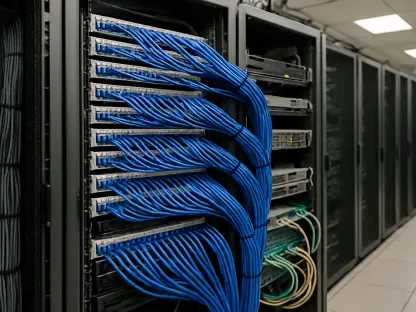On April 28, a sweeping power outage enveloped the Iberian Peninsula, casting a shadow over technological connectivity in Portugal, Spain, and parts of nearby countries. With Internet traffic grinding to a near standstill, the blackout revealed the fragile interplay between power and online connectivity. Armed with data insights from Cloudflare, this article examines the myriad ways the outage impacted Internet traffic, delving into the details of network quality, routing operations, and regional fluctuations. These considerations uncover not just the immediate effects but also paint a picture of underlying infrastructure challenges, setting a stage for future preventive strategies.
The Immediate Effects on Internet Traffic
Sudden Traffic Drop
The Iberian blackout served as a wake-up call to the relationship between power stability and Internet functionality. Portugal witnessed its Internet traffic plummet to unprecedented levels, dropping by half almost immediately. This rapid decline was compounded, with traffic levels descending 90% below their norm within hours. Such drastic shifts weren’t isolated to Portugal; Spain mirrored this trajectory with an initial 60% decrease, spiraling to 80% below standard operations. These statistics underscore the immediate and severe implications of the power outage on digital connectivity. The numbers not only highlight the dependency of Internet services on steady power supplies but also provide a tangible metric illustrating the scope of the blackout’s impact.
Both nations faced a veritable digital abyss as online traffic patterns were thrown into disarray. Essential services, already weighed down by the outage, faced further disruptions as network congestion exacerbated connectivity challenges. Within this turbulent environment, businesses that relied on online platforms for operations encountered significant hurdles, compounding economic ramifications amidst the power crisis. These levels of disruption emphasize the imperative for regions to bolster their infrastructure resilience to mitigate against such sweeping impacts.
Regional Discrepancies
The effects of the April blackout didn’t paint a uniform picture across the Iberian Peninsula, highlighting just how variable the impacts were from region to region. Major metropolitan areas like Lisbon and Madrid experienced pronounced traffic declines, yet their respective recovery processes hinted at underlying resilience. These cities, through well-established infrastructures, demonstrated an ability to quickly begin stabilization, albeit within a challenging environment. Conversely, smaller and less developed regions bore the brunt of prolonged Internet disruptions. Areas including Navarre and La Rioja, however, provided a contrasting tale of gradual recovery, showcasing an encouraging response as power was incrementally restored.
The discrepancy in Internet recovery between metropolitan hubs and less populated regions underscores a critical aspect of digital infrastructure planning. A one-size-fits-all solution proves inadequate in regions rife with geographic and infrastructural variation. These differing impacts amplify the necessity for tailored crisis management strategies, taking into account unique local factors. The data paints a mosaic of experiences that collectively stress the importance of crafting robust and region-specific policies to achieve equitable and comprehensive recovery.
Degradation in Network Quality
Reduced Connectivity
The blackout’s repercussions extended beyond mere offline periods, seeping into the quality of Internet services that remained operable. Portugal’s plummet in median download speeds from 40 Mbps to a staggering 15 Mbps manifested a profound compromise in service quality. Concurrently, latency levels doubled, further hindering users’ ability to seamlessly surf the web or perform online tasks. In Spain, the narrative followed a similar path, with connectivity suffering stark reductions. Median download speeds sank from 35 Mbps to 19 Mbps, and latency similarly inflated, painting a picture of constrained bandwidth and diminished user experience.
This degradation unveiled the numerous challenges Internet providers faced as networks became bottlenecked and less capable of efficient data transmission. Households and businesses relying on stable connections found themselves at a standstill, complicating both daily routines and operational efficiencies. The impediments reinforced the need for networks designed not just for peak performance, but also resilience under compromised conditions. The interoperability of technological systems took center stage as stakeholders began examining opportunities for enhanced robustness in design and implementation.
Network Congestion
Compounding connectivity challenges, network congestion presented a formidable obstacle in the post-blackout landscape. As power grid failures incapacitated fixed networks, the remaining operational links buckled under the pressure of increased traffic loads. This intensification of demand surfaced clear limitations in existing infrastructure, resulting in bottlenecks that curtailed efficient data flow. Residents faced an uphill battle to maintain even basic Internet connectivity, further exacerbated by the outage’s duration.
The scenario spotlighted inherent vulnerabilities within current network architectures, highlighting a critical need for enhancing infrastructure adaptability during crises. With growing dependency on Internet services for both personal and professional spheres, ensuring network stability despite fluctuating conditions has never been more pivotal. Addressing these congestion issues necessitates visionary strategies in data management and network distribution to ensure continued functionality in adverse scenarios, preparing for a digitally demanding future.
Network Infrastructure and Routing Impacts
IP Address Space Reduction
The blackout precipitated a profound reshuffling of digital landscapes, most visibly manifested through a significant reduction in announced IP address spaces. Portugal and Spain reported notable declines in IPv4 and IPv6 announcements, signifying a truncation in network visibility and reachability. This contraction in address space adversely affected certain networks’ ability to maintain stable connections, as it essentially rendered parts of the infrastructure invisible.
Navigating these changes posed substantial challenges for network administrators, tasked with mitigating the fallout while preserving operational stability. The predicament highlights an often-overlooked facet of network resilience, stressing the importance of maintaining ample IP resources to withstand unexpected perturbations. As digital communication platforms become entrenched as vital societal cornerstones, scrutinizing network management strategies to bolster resilience against widespread disruptions remains imperative to upholding digital integrity.
Broader European Effects
The ripple effects of the Iberian blackout extended beyond immediate national borders, touching parts of Andorra, France, and Morocco. While these regions did not experience the severe Internet traffic disruptions noted in Iberia, subtle implications on their networks were nonetheless recorded. Certain French localities, for instance, experienced marginal declines which were rapidly remedied, illustrating the adaptive capabilities of regional systems.
These broader impacts reflect the intricate interconnectedness that characterizes modern network ecosystems. They render visible the cascading consequences of infrastructural upheavals, revealing vulnerabilities in geographically distant but digitally linked systems. Understanding these intertwined systems is crucial for developing comprehensive contingency plans that anticipate possible extended consequences, ensuring preparedness in facing similar scenarios. The significance of precautionary measures echo across borders, advocating for an international cooperative framework that seeks to fortify shared digital landscapes.
Adaptive Responses and Challenges
Shift to Mobile Networks
Faced with a stark reduction in fixed network functionality, residents turned to mobile networks as an alternative means of maintaining communication and access to information. Initially, this shift offered a temporary reprieve, sustaining connectivity through the burgeoning crisis. However, the escalated demand soon overwhelmed mobile infrastructure, exposing the limitations of these networks when operating under duress. The resultant strain observed on mobile services highlighted a pressing need for enhanced capacity and scalability to respond effectively to such exigencies.
This pivot to mobile platforms underscores an essential adaptation during infrastructure failure, evoking dialogue around augmenting network capabilities to withstand future shocks. The experience shines a light on the necessity of layered technological solutions, blending both fixed and mobile networks to ensure continuity. As digital reliance proliferates, innovative approaches to network planning and resource allocation ensure sustained connectivity amidst unpredictability.
Importance of Resilient Infrastructure
The Iberian Peninsula experienced a significant power outage on April 28, impacting Portugal, Spain, and parts of nearby countries. This unexpected blackout drastically slowed Internet traffic, underscoring the delicate relationship between electrical power and technological connectivity. The disruption highlighted vulnerabilities in the infrastructure that supports online networks, prompting concerns about the resilience and adaptability of current systems. By analyzing data from Cloudflare, we can explore the outage’s impact on Internet traffic, focusing on network quality, routing operations, and regional fluctuations in online engagement.
The ramifications of this outage were more than just immediate disruptions. They revealed deeper infrastructure challenges that could potentially lead to future similar incidents if not addressed. This analysis serves to emphasize the critical nature of integrating robust power systems for technology, pushing for infrastructure improvements and preventive strategies. As the world continues to depend heavily on seamless connectivity, understanding these dynamics becomes crucial for crafting solutions that ensure stability and resilience.









